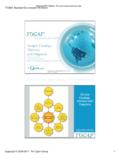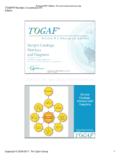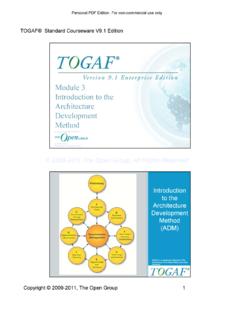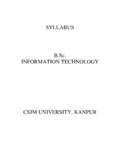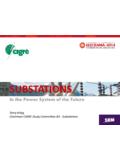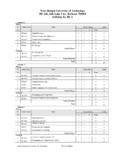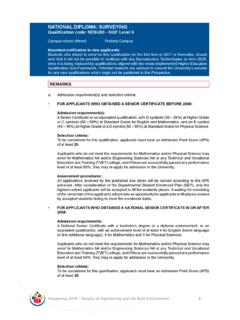Transcription of Module 7 TOGAF Content Metamodel - The Open …
1 TOGAF Standard Courseware V9 EditionCopyright 2009, The Open Group1of 45 Slide 1 TMModule 7 TOGAF Content MetamodelV9 Edition Copyright January 2009 All rights reservedPublished by The Open Group, January 2009 of 45 Slide 2 TMTOGAF Content MetamodelTOGAF is a trademark of The Open Group in the United States and other countriesTMPersonal PDF Edition. For non-commercial use only 2009 The Open Group, All Rights ReservedTOGAF Standard Courseware V9 EditionCopyright 2009, The Open Group2of 45 Slide 3 TMRoadmap Part IV, Architecture Content Framework, Chapter 34 Part I - IntroductionPart II Architecture Development MethodPart III ADM Guidelines and TechniquesPart IV Architecture Content FrameworkPart V Enterprise Continuum and ToolsPart VI Reference ModelsPart VII Architecture Capability FrameworkPreface, Executive Overview, Core Concepts.
2 Definitions and Release NotesIntroduction to ADMADM Phase NarrativesArchitectural ArtifactsArchitecture DeliverablesBuilding BlocksGuidelines for Adapting the ADM ProcessTechniques for Architecture DevelopmentEnterprise ContinuumArchitecture PartitioningArchitecture RepositoryTools for Architecture DevelopmentFoundation Architecture: Technical Reference ModelIntegrated Information Infrastructure Reference ModelArchitecture BoardArchitecture ComplianceArchitecture ContractsArchitecture GovernanceArchitecture Maturity ModelsArchitecture Skills FrameworkContent Metamodelof 45 Slide 4 TMModule ObjectivesThe objectives of this Module are to describe: What a metamodelis and why it is needed Key concepts of the Core Metamodel The division of the metamodelinto Core and Extensions Key concepts of the Core Metamodel Entities The components of the TOGAF Content Metamodel Personal PDF Edition.
3 For non-commercial use only 2009 The Open Group, All Rights ReservedTOGAF Standard Courseware V9 EditionCopyright 2009, The Open Group3of 45 Slide 5 TMWhat is a Metamodel ? A Metamodel is a precise definition of the constructs and rules needed for creating models Source A model that describes how and with what the architecture will be described in a structured way. TOGAF 9 definitionsof 45 Slide 6 TMWhy a Metamodel ?Personal PDF Edition. For non-commercial use only 2009 The Open Group, All Rights ReservedTOGAF Standard Courseware V9 EditionCopyright 2009, The Open Group4of 45 Slide 7 TMBenefits of the MetamodelThe Content Metamodel provides a number of benefits: It formalizes the definition of an Enterprise Architecture It formalizes the relationship between objects It enables an EA tool mappingof 45 Slide 8 TMFormal and Informal Modeling When defining the architecture for an Enterprise or solution, there are choices to be made on the level of structure and formality that is necessary to appropriately capture and describe architectural direction In certain circumstances, very formal specific language is needed in order to articulate and govern in a precise or detailed ways In other circumstances the use of formal engineering discipline will result in architecture Content that is inappropriate for the audience and difficult to communicatePersonal PDF Edition.
4 For non-commercial use only 2009 The Open Group, All Rights ReservedTOGAF Standard Courseware V9 EditionCopyright 2009, The Open Group5of 45 Slide 9 TMCore Content Metamodel Concepts A TOGAF architecture is based on Defining architectural building blocks within architecturecatalogs Specifying the relationships between those building blocks in architecturematrices And presenting communication diagramsthat show in a precise way what the architecture is The Metamodel is structured into Coreand Extensioncontent Core Content is designed not to be alteredof 45 Slide 10 TMCore and Extension Content In order to support many scenarios the Metamodel has been partitioned into core and extension Content The core provides a minimum set of architectural Content to support traceability across artifacts The extensioncontent allows for more specific or more in-depth modelingPersonal PDF
5 Edition. For non-commercial use only 2009 The Open Group, All Rights ReservedTOGAF Standard Courseware V9 EditionCopyright 2009, The Open Group6of 45 Slide 11 TMTOGAF Content Metamodel and its Extensionsof 45 Slide 12 TMCore Metamodel Entities Actor: A person, organization, or system that is outside the consideration of the architecture model, but interacts with it. Application Component: An encapsulation of application functionality that is aligned to implementation structuring. Business Service: Supports business capabilities through an explicitly defined interface and is explicitly governed by an organization. Data Entity: An encapsulation of data that is recognized by a business domain expert as a discrete concept. Data entities can be tied to applications, repositories, and services and may be structured according to implementation considerations.
6 Function: Delivers business capabilities closely aligned to an organization, but not explicitly governed by the organization. Personal PDF Edition. For non-commercial use only 2009 The Open Group, All Rights ReservedTOGAF Standard Courseware V9 EditionCopyright 2009, The Open Group7of 45 Slide 13 TMCore Metamodel Entities (Cont d) Organization: A self-contained unit of resources with line management responsibility, goals, objectives, and measures. Organizations may include external parties and business partner organizations. Platform Service: A technical capability required to provide enabling infrastructure that supports the delivery of applications. Role: An actor assumes a role to perform a task. Technology Component: An encapsulation of technology infrastructure that represents a class of technology product or specific technology product.
7 Of 45 Slide 14 TMCore Entities and their RelationshipsPersonal PDF Edition. For non-commercial use only 2009 The Open Group, All Rights ReservedTOGAF Standard Courseware V9 EditionCopyright 2009, The Open Group8of 45 Slide 15 TMStakeholder NeedsEnterpriseSecurityQA / Standards GroupsProductSpecialistsTechnicalSpecial istsProgrammeManagement OfficeProcurementHRExecutiveLine ManagementBusinessDomainExpertsIT ServiceManagementApplicationManagementMa nagementData / VoiceCommunicationsLineManagementExecuti veFunctional /Business ProcessExpertsCxOStakeholder TypesCorporateEnd - UserSystemProjectInfrastructureof 45 Slide 16 TMThe Content MetamodelThe Content Metamodel provides definitions of all the types of building blocks that may exist, showing how they can be described and related to one another.
8 When creating and managing architectures, it is necessary to consider concerns such as business services, actors, applications, data entities, and technology. The Metamodel highlights these concerns, shows their relationships and identifies artifacts that can be used to represent them in a consistent way. The Metamodel can also be used to provide guidance to organizations that wish to implement their architecture using an architecture PDF Edition. For non-commercial use only 2009 The Open Group, All Rights ReservedTOGAF Standard Courseware V9 EditionCopyright 2009, The Open Group9of 45 Slide 17 TMContent Metamodel (Simplified)of 45 Slide 18 TMContent Metamodel (Detailed)Personal PDF Edition. For non-commercial use only 2009 The Open Group, All Rights ReservedTOGAF Standard Courseware V9 EditionCopyright 2009, The Open Group10of 45 Slide 19 TMCore Content Metamodelof 45 Slide 20 TMCore Architecture ArtifactsPhase A, Architecture Vision Stakeholder Map matrix Value Chain diagram Solution Concept diagramRequirements Management Requirements catalogPhase C, Application Architecture Application Portfolio catalog Interface catalog System/Organization matrix Role/System matrix System/Function matrix Application Interaction matrix Application Communication diagram Application and User Location diagram System Use-Case diagramPhase E.
9 Opportunities & Solutions Project Context diagram Benefits diagramPhase C, Data Architecture Data Entity/Data Component catalog Data Entity/Business Function matrix System/Data matrix Class diagram Data Dissemination diagramPhase D, Technology Architecture Technology Standards catalog Technology Portfolio catalog System/Technology matrix Environments and Locations diagram Platform Decomposition diagramPhase B, Business Architecture Organization/Actor catalog Role catalog Business Service/Function catalog Business Interaction matrix Actor/Role matrix Business Footprint diagram Business Service/Information diagram Functional Decomposition diagram Product Lifecycle diagramPreliminary Phase Principles catalogPersonal PDF Edition. For non-commercial use only 2009 The Open Group, All Rights ReservedTOGAF Standard Courseware V9 EditionCopyright 2009, The Open Group11of 45 Slide 21 TMFull Content Metamodelof 45 Slide 22 TMFull Content Metamodel with RelationshipsPersonal PDF Edition.
10 For non-commercial use only 2009 The Open Group, All Rights ReservedTOGAF Standard Courseware V9 EditionCopyright 2009, The Open Group12of 45 Slide 23 TMFull Content Metamodel Artifactsof 45 Slide 24 TMMetamodel ExtensionsPersonal PDF Edition. For non-commercial use only 2009 The Open Group, All Rights ReservedTOGAF Standard Courseware V9 EditionCopyright 2009, The Open Group13of 45 Slide 25 TMGovernance Extensionof 45 Slide 26 TMGovernance Extension Scope: The ability to apply measures to objectives and then link those measures to services The ability to apply contracts to service communication or service interactions with external users and systems The ability to define re-usable service qualities defining a service-level profile that can be used in contracts Creation of additional diagrams to show ownership and management of systems Additional diagrams to be created: Enterprise Manageability diagramPersonal PDF Edition.

